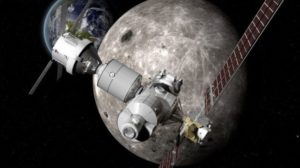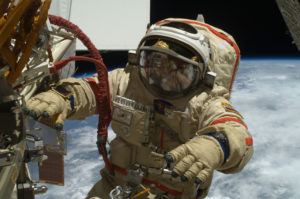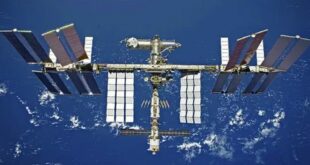
Lunar Orbital Platform – Gateway (LOP-G) is a future international lunar orbiting outpost, planned to be built in the 2020s. We talked about the development of the project, its tasks and goals as well as about Russia’s participation with Oleg Valerievich Kotov, pilot-cosmonaut of the Russian Federation, recipient of the Hero of the Russian Federation medal, veteran of three space missions, currently Deputy Director for Science at the Institute of Biomedical Problems (IMBP) of the Russian Academy of Sciences.
Oleg Valerievich, tell us please about the Lunar Orbital Platform – Gateway project. Have any memorandums or cooperation agreements been signed with NASA or everything is only just an idea now?

The LOP-G (Lunar Orbital Platform-Gateway) project, formerly called Deep Space Gateway, and now simply Gateway, is an international project that is being implemented by the nations participating on the International Space Station (ISS) project within the ISS memorandum. All partners have come to the conclusion that the cooperation formed during the development and implementation of the ISS project should be continued. As a result, the Gateway project has been developed, which is a station to be constructed and operated in the vicinity of the Moon.
Now pre-project research, distribution of roles and new station shaping are being carried out. Several large international meetings have already been held, including meetings of groups dealing with the station´s integration and the definition of its functions (the groups work within the ISS project).
The station will orbit the Moon not in the classical plane orbit, but in the so-called halo-orbit – this is a very ‘tricky’ orbit, which has a complex shape. Orbital parameters are about from 4 to 75 thousand km, that is, they have a sufficiently large orbital period. Electric thrusters that use xenon as propellant will be the station’s main propulsion system, because this type of orbit requires constant adjustments.
The partners have taken up different tasks. Each particular module will be a certain partner’s responsibility. The first module to be launched is the American PPM (Power Propulsion Module). Russia is to develop what was initially called the Airlock module, but now it is called the Multi-purpose module, because apart from providing the airlock capability, it will double as auxiliary and scientific equipment storage area as well. The station will be much smaller than the ISS, with only 6 or 7 modules, and it should become operational by 2026. The multipurpose module is the last to be launched in 2026, and after that the station is to become operational.
A letter of intent was signed with with NASA in Adelaide last year by the heads of Roscosmos and NASA. The relevant departments of Roscosmos are working on regulatory documents, because construction always means big money. Other space agencies including NASA are in the same situation. At the moment we are at the research and development stage. A technical proposal should be the result of the R&D stage, and the scope of work will become obvious from it and the cost will be determined. It will be possible to present this document to the government with a request for funding. As soon as each participant understands their role, the project will be given further impetus.
What has been the role of Roscosmos in the LOP-G project so far? Why is a human outpost planned to be built in an orbit around the Moon, not on its surface?
The LOP-G is a lateral part of the Roscosmos core strategy. Our space policy’s main goal is to put humans on the Moon and create the infrastructure on the surface of the Moon. Gateway in this case becomes an intermediate link, the ‘forerunner’ of this stage.
The American concept of landing on the Moon is exactly the same. All partners make no secret they are set to land on the lunar surface, but they are are going to start crewed lunar missions from an orbiting outpost instead of going to the surface directly, which will allow them to understand the Moon better, to operate automatic vehicles, and to choose the right location for a lunar base on the surface.
All lunar base projects are designed to utilize local resources, especially water in one aggregate state or another. To do this, you must at least know where to look for it. So, the LOP-G will be an orbiting outpost. Landers are being developed for it, a system of reusable take-off and landing modules that are completely different from the Apollo times: a reusable small lander designed to sample soil for research and a large heavy lander that will deliver crews to the surface of the Moon. Only refueling tankers will be sent from the Earth.
What launch vehicles, including Russian ones, is it planned to use for delivering the station parts to the near-moon orbit?
Delivering the station’s modules and placing them into orbit will be as co-manifested payloads on the Space Launch System (SLS) super heavy rocket, along with the Orion spacecraft. Logistically, it is quite possible that some of the elements will be delivered not by SLS, but by commercial rockets, for example, SpaceX’s Falcon Heavy. At the same time, Russia is considering the possibility of launching its Multi-Purpose Module on two Russian Angara rockets. Also, Japan offers to develop the HTV-X cargo ship, which can be launched on a Japanese rocket.
The choice of the launch vehicle for launching our module depends not only on whether the Angara rocket is ready for launch, but on how we can get to the target orbit and docking with the station. Besides the rocket, an upper stage and navigation and docking systems are required. We are considering the variant with the Angara launch vehicle, but nevertheless, the SLS-Orion system will be used for launching the Multi-Purpose Module with 99% certainty. The delivery scheme is as follows: our module is placed by the SLS in a parking orbit, then Orion docks with the module and tugs it to the station and docks it.
The Rocket and Space Corporation Energia is developing a new Russian crewed spacecraft called Federatsiya (‘Federation’). Will Federatsiya be capable of delivering international crews to the LOP-G?
It will. Apart from the Multi-Purpose Module Russia will contribute the Federatsiya spacecraft that will serve the second transportation system for the project as it is always wise to have a backup system.
The station is currently planned to operate in an automatic mode most of the time. At the assembly stage, the first crew will spend 14 days on the station, and two more crews will do a 30-day mission each. On average the station will have a crew for about 30 days once a year. We will have to keep it like this due to the high cost of the SLS rocket. But if we use the Federatsiya spacecraft, more frequent crew rotations might be possible.
Is it possible to consider Russia’s participation in the LOP-G project a breakthrough?
Certainly. This project will allow Russia to remain on the list of space-faring nations that possess advanced technologies. There’s no doubt that being part of this project will benefit our space industry. Unlike the ISS project, which we entered with our unique technologies, the new station will give us an opportunity to adopt the most cutting-edge technologies that our partners have. At the LOP-G, for example, a fundamentally different life support system (LSS) will be tested.
The cislunar station is being developed by an international partnership. What do you think are the similarities and differences between the LOP-G and the ISS projects?
The difference is that the ISS is a station in low earth orbit, whereas the LOP-G will work in the Moon’s vicinity.
In fact, both the ISS and the Moon are just stages of a global road map for deep space exploration. If we going to go to Mars and beyond, do crewed missions to the surface of the Moon, to the near-moon station and to the ISS, and even ground-based simulation experiments, we should regard these outposts as just complex stages of a single long path to getting ready for deep space missions technologically.
If you don’t want to go to Mars just to plant a flag there, but to come and stay there, to study it, survive the harsh Martian conditions and come back to the Earth, you first need to come up with a list of technologies that you need to create and test. There is a certain type of technologies that can be tested only on the Moon, the other type only on the ISS, and the other type only on Earth (in Earth’s gravity). So, all flight scenarios are considered from this point of view, and the difference between the projects is they use different orbits.
The lunar orbiting outpost will allow humans to return to deep space for the first time since 1972. Will this project help prepare us for a crewed mission to Mars or will only be just a waste of resources?
It’s impossible to fly to Mars if you are not ready for that. To get to the Red Planet, you need to learn how to work in deep space. Humans have got a great proving ground just around the corner, the Moon. Why did we choose this ‘tricky’ orbit for the new station? One of the reasons is the study of the inhomogeneous gravitational fields properties in a system of three large mass-bodies (centers of mass) – the Sun, the Earth and the Moon. The ability to navigate in this kind of gravitational fields will be come in handy for the Mars mission, which will be based on the gravity maneuvering principles.
This explains why the LOP-G station will not operate at an altitude between 150 and 200 km. A low orbit might seem like a very good idea logistically as it is close to the lunar surface. But we have to think with future missions in mind. We want to get to Mars. Why is the station called Gateway? Simply because it’s a ‘gate’, a ‘portal’ into deep space.
The LOP-G configuration and its modules are similar to an interplanetary spacecraft. The components of the near-moon station will be more functional, but less scientific. The ISS was built as a near-Earth scientific laboratory, and LOP-G will rather become a technological laboratory as it will carry out more tests than research. For example, LOP-G will test life support systems, long-range navigation, communication, radiation protection, etc.
The radiation background in the LOP-G orbit will be different from that in the ISS orbit, which is just 400 km above the Earth. The lunar radiation background has a different spectrum and has a different biological effect on the human body. To study this type of radiation, some tests on animals are currently carried out, and approximately in 2021 or 2022, the Bion-M2 satellite with biological objects will be launched with the participation of the Institute of Biomedical Problems (Russian Academy of Sciences). The satellite will fly above the magnetic belts of the Earth and it will enable scientists to study radiation on living organisms in a higher orbit (more than 1000 km). Later, new radiation protection methods will be tested at the LOP-G.
About the interviewer:
Evgeniy Ryzhkov studied space programs for two years in Japan and worked as a technical translator from Japanese at various factories. He is currently an editor and reporter with the ‘Novosti Kosmonavtiki’ magazine.
 SpaceWatch.Global An independent perspective on space
SpaceWatch.Global An independent perspective on space




